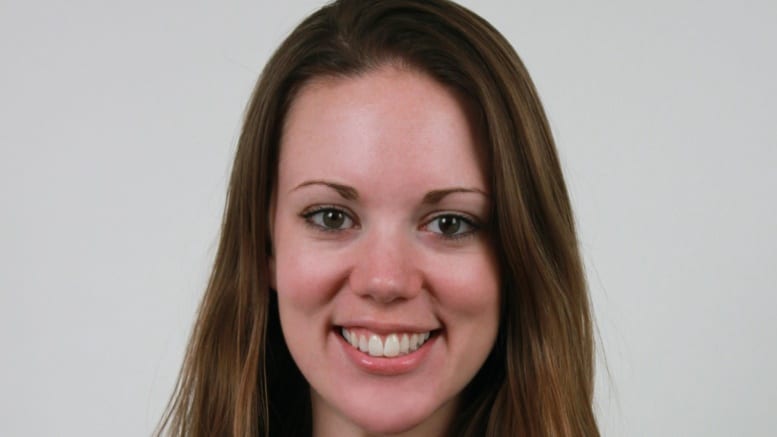If you’ve ever tried to swaddle a newborn, you know it’s not so easy. But swaddling gives newborns great comfort, and so parents have been making the effort for centuries.
What might be news is that proper swaddling, which includes placing the newborn on their back to sleep, is also one of many steps that can keep babies safe while sleeping.
At the Women and Children’s Center at FirstHealth Moore Regional Hospital, Pinehurst, physicians and nurses have just begun offering parents a new way to swaddle newborns. It’s called a “sleep sack,” and it was a big hit the first week parents used it. Further, it could play a role in preventing sudden infant death syndrome, or SIDS, which is the leading cause of death among babies between one and 12 months old.
“As a parent myself, I’ve experienced the learning curve when trying to use blankets to swaddle my baby,” says Nicole S. McMahon, M.D., pediatric hospitalist at FirstHealth. “It sometimes takes a few weeks to master it, and parents are pretty busy with other things during those first weeks at home with their newborns.”
In contrast, sleep sacks are extremely easy to use, she says, and they are part of FirstHealth’s efforts to educate everyone about “safe sleep” for babies.
Sleep sacks are blankets that usually zip up the middle, have cut-outs for the baby’s arms and head, are roomy around the hips and legs, and are sewn closed at the feet. The “swaddling” feature uses wide pieces of fabric that fasten gently around the babies arms and shoulders, but keep the hips, legs and feet free—but warm.
The feeling of swaddling can be a great comfort to a newborn. It’s especially helpful during the first few months of life, when their “startle reflex” causes them to suddenly extend their arms and legs and arch their back. This sudden movement can wake them from a sound sleep. A snug swaddle helps them feel secure.
“Compared to the challenge of first learning to swaddle with a blanket, this is easy,” says Beth Hutchinson, administrative director of women and children’s care at FirstHealth. A team investigated the value of sleep sacks, and brought the idea to FirstHealth.
“Our parents loved it from the first day we offered it. And it gives both moms and dads confidence that they can swaddle their babies, in the hospital and when they go home.”
Beginning in January, FirstHealth now also sends each newborn home with a new sleep sack, instead of the traditional blanket.
Staff also use sleep sacks to create an opportunity for parents to learn the latest about safe sleep for newborns, Hutchinson says. The goal is to prevent sudden infant death syndrome, or SIDS.
“With five or six babies born at FirstHealth every day, that’s a lot of education,” says Hutchinson. “Our staff is excited to have this additional opportunity to talk about preventing SIDS.”
SIDS is the death of a baby that seems healthy, often while they are sleeping. It is possibly due to defects in the baby’s brain that control either breathing or the ability to wake up.
“One risk for SIDS is having extra blankets, pillows, toys and other soft items in a crib, which can interfere with breathing.” says Dr. McMahon. “Sleep sacks keep the baby warm, so no other blankets are needed.”
The sacks come in different sizes. For the tiniest of babies in the neonatal intensive care unit (NICU), special versions also include openings to reach the baby for IVs.
At FirstHealth, it’s clear that parents are heeding the message of “no extra blankets.”
“In the first few days we offered sleep sacks, parents used them exclusively,” she says. “We didn’t see any extra pillows or blankets in the crib, just the baby by themselves. That’s exactly what we want. It’s safer.”
Because sleep sacks are looser below the waist, they are also a healthy alternative to tight swaddling.
“To develop properly, babies need to move their hips and legs, and the sleep sacks provide the room for that,” says Dr. McMahon.
“Once a baby shows signs of rolling over, typically around three months old, they should no longer be swaddled,” adds Dr. McMahon. “Keep in mind that all children develop at different rates, and if your child shows signs before then, you should stop swaddling. You can still use a sleep sack; just don’t use the swaddling wraps. Parents can also buy or make sleep sacks without that feature.”
According to Dr. McMahon, it is important to note that daycare establishments follow separate safe sleep practices as directed by the state. Each daycare center licensed to care for infants aged 12 months or younger is required to develop, adopt and comply with a written safe sleep policy. The policy states that no pillows, wedges or other positioners – pillow-like toys, blankets, toys, bumper pads, quilts, sheepskins, loose bedding, towels and washcloths – or other objects may be placed with a sleeping infant aged 12 months or younger. It also states that while in the daycare setting, children shall not be swaddled.
FirstHealth began using sleep sacks in January 2018. They will use them in the hospital for the 2,000 babies born there each year, and send a new one home with each newborn, as well.
Simple but important steps to prevent SIDS
Sudden Infant Death Syndrome, called SIDS or “crib death,” is the leading cause of death among babies between one and 12 months of age, according to the American Academy of Pediatrics (AAP).
“One of our biggest goals is to educate families of newborns about safe sleep and SIDS,” says Nicole S. McMahon, M.D., pediatric hospitalist at the Women and Children’s Center at FirstHealth Moore Regional Hospital, Pinehurst. “Using sleep sacks is one step, but there are many other important steps to keep babies safe in their cribs.”
Staff at the FirstHealth Birthing Center shares these guidelines from the AAP for babies up to one year old, to help prevent SIDS in the community.
Tips for baby’s safe sleep:
- Put your baby on their back for sleep—for naps and at night.
- Create an area in your room for the baby to sleep for the first 6 months or, ideally, for the first year. This can decrease the risk of SIDS by 50 percent, the AAP says.
- A baby should sleep only on a firm surface, never in an adult’s bed, on a couch or armchair.
- The baby should sleep with nothing else in the crib. This includes crib bumpers and other soft objects, like blankets, pillows or toys.
- If you swaddle your baby, make sure the swaddle is not too tight or does not make it hard for the baby to breathe. The baby should also be able to move their hips. Stop swaddling when the baby starts trying to roll over.
- Only bring your baby into your bed for feedings or to comfort them. Do not let them sleep with you.
- The AAP also suggests giving a pacifier at naptime and bedtime. But do so after breastfeeding is going well, after about two or three weeks.
Also, since babies should sleep on their backs, give them the chance when awake to be on their stomachs. This helps them build other important muscles. Always watch them during these times, experts say.











